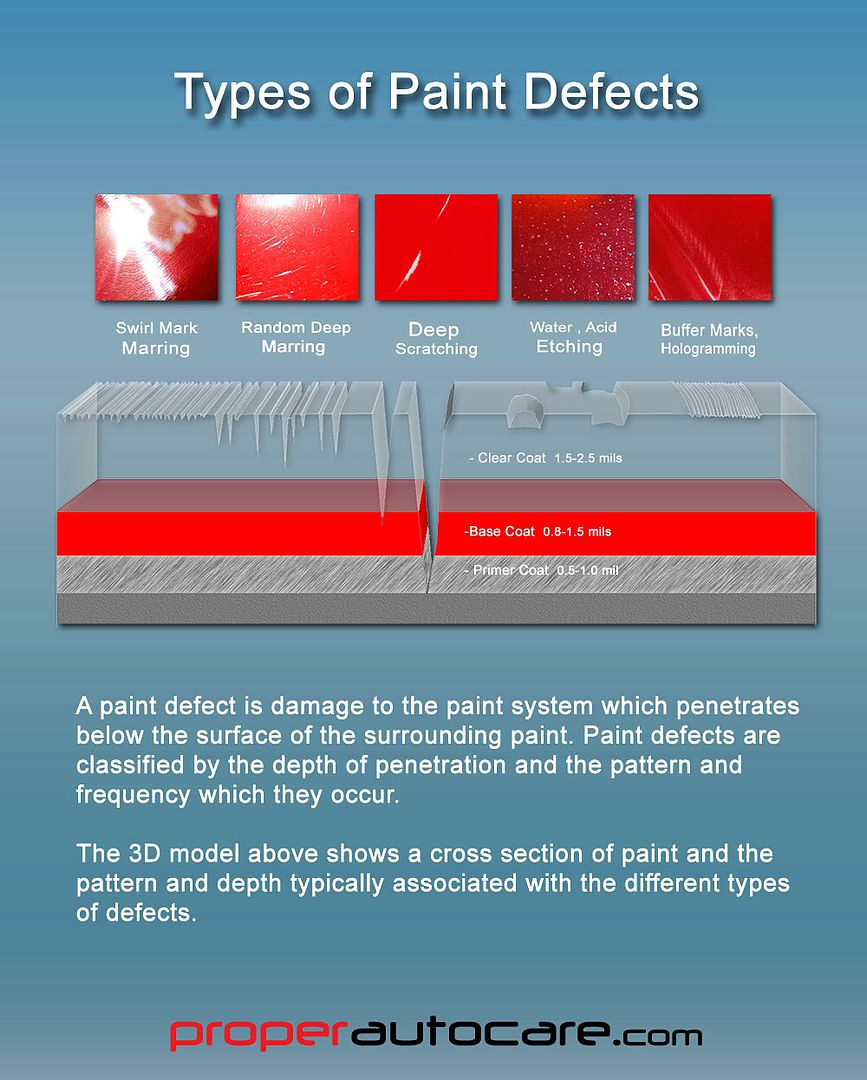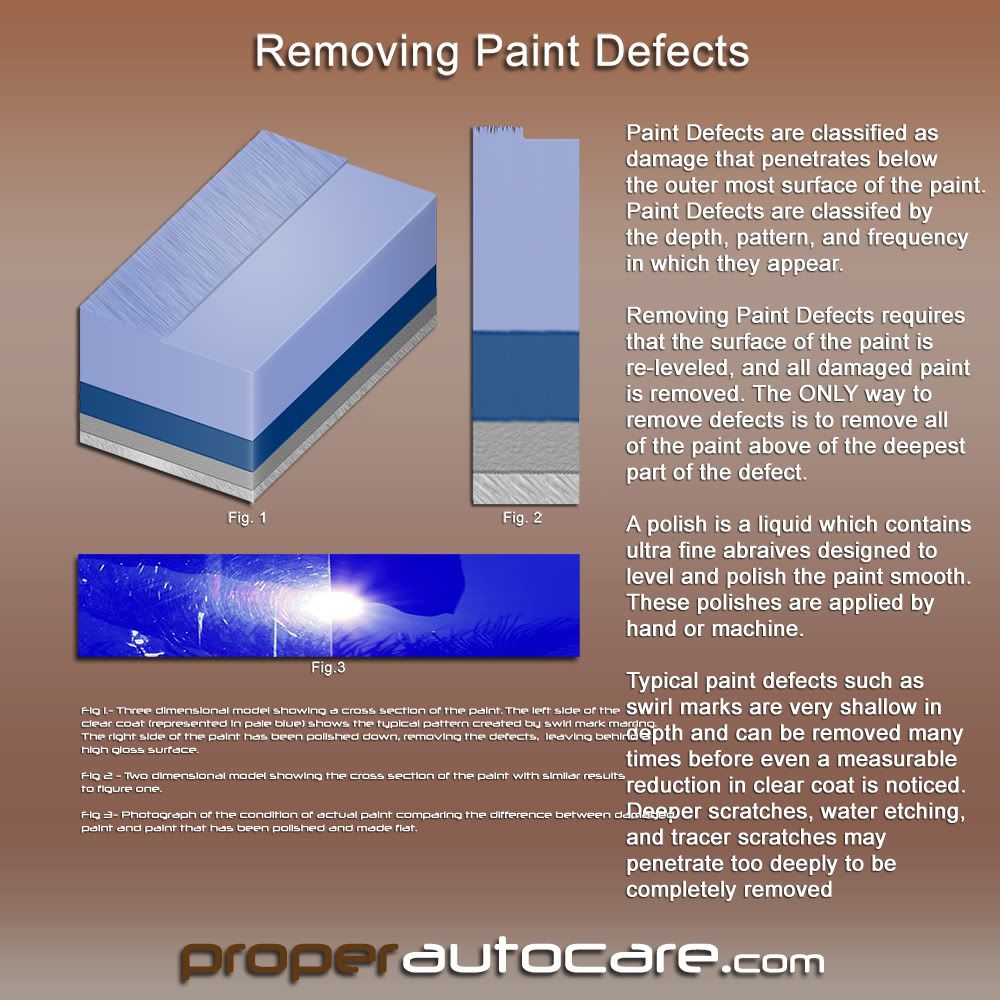How do you restore or improve your car?s shine? It is a common question, and the answer is one of the most misunderstood in car care! From the second the automobile is painted it begins to age. Modern paint systems are scratch sensitive and must be washed with the proficiency of a brain surgeon. They often are not leaving even brand new cars at the dealership as victims of paint defects.
When a car is first painted, the surface is relatively smooth and uniform. Like a smooth mirror, the paint reflects maximum light. From the first incorrect wash (often at the factory) the surface becomes scoured. Thousands of small scratches are ground into the surface. As the car faces it?s life on the road and in the environment it is attacked with fall out from rain, parking lot scratches, the neighbor?s cat, and little Johnny using it as a Hot-Wheels race trace.
The once ocean smooth surface of the paint now looks like a mountain range under a microscope. The uniform surface that reflected light perfectly is so uneven that light scatters away in different directions. The paint no longer is as wet or glossy looking.
This penetrating damage that causes the degradation in appearance is known as Paint Defects. Paint Defects are areas where paint has been removed, creating a rough surface.
Paint Defects are characterized by the by the depth which the penetrate the surface, as well as the frequency which they occur and the pattern they created.
Marring
Marring is often a term often used to frequently occurring, shallow paint defects.
Swirl Mark Marring- Swirl Mark marring is likely the most common type of defect. It is extremely shallow in depth and is very frequent in occurrence. Most swirl mark marring is wash induced and caused by incorrect washing and drying techniques. Because these paint defects are so easy to get and thus occur so frequently, they forum a circle pattern of scratches that reflect outwards from a central light source giving this marring it?s name sake: Swirl Marks or Spider Webbing.
Random Deep Marring is often wash induced but with a greater degree of force implicating more damage to the paint?s surface. A piece of grit stuck in a wash mitt or drying towel can cause isolated spots of deep marring; Washing a car with a shop brush or using an automated car wash can cause frequent spots of deep marring. Incorrect sanding of the vehicle?s paint can cause very deep marring also known as sanding tracers. Random Deep Marring occurs in different patterns and frequency, but is characterized by the depth of damage: Deep enough to see, but not deep enough to feel. In frequent deep marring is often referred to as Random Isolated Deeper Scratching or RIDS.
Scratching
Scratches are paint defects where a significant amount of paint has been removed and the defect is not only visible but can be felt to the touch. In general scratching/deep scratching penetrates too deeply into the paint?s surface to be completely removed, although the appearance may be lessened.
Etching
An etching is a type of paint defect that can very in depth and frequency, but creates a unique pattern dependant on how it is created. Etching is caused by chemical reaction on that paint?s surface that eats dissolves the surface at a fairly consistent rate of a relatively large area, creating depressions on the surface that appear like empty swimming pools. The most common forms of etching are from acid rain, acidic insect remains and bird bombs, and from the residual minerals found in water.
Machine Created Polish Marks
Holograms are extremely consistent, extremely shallow frequently occurring paint defects created by the machine polishing of paint. These defects are so frequent and shallow that they reflect light in their own unique pattern, creating a three dimensional appearance in the paint, hence the name hologramming. Hologramming is must often created by a high speed rotary polisher, allow dual action polishers can create a similar pattern if the pad is rotating fast enough. The pattern of ultra fine marks created by dual action polishers is often more random in nature and creates a pattern known as micro-marring or micro haze.
Paint Defect Removal
To remove a paint defect itself is impossible cause a paint defect is area where the paint has already been removed. To remove a paint defect means that all of the surrounding paint above the deepest part of the defect needs to be removed in order to create a more level surface. This new surface will be smooth and reflect maximum light. Because new cars are frequently damaged at the dealership, often this new fresh, smooth surface will improve the appearance of new vehicles dramatically as well.
The diagram below illustrates the difference between paint with paint defects and what removing them means.
Methods for Paint Defect Removal
By hand: Modern clear coats are much harder then their older, single stage counter parts. However modern technology increases have made it more possible to remove paint defects by hand. Keep in mind that the polishes used to remove paint evenly require a lot of work and this is the slowest method possible.
By machine: With the rise in popularity of Dual Action polishers, many enthusiast have taken to machine polishing their cars themselves. Machine polishing with a Dual Action is very safe and affords great results with a great margin of safety. Some enthusiasts and many professionals use a Rotary Polisher to polish paint. These powerful machines are capable of quickly removing the deepest marring marks but can also damage paint in the hands of an inexperienced user.
Removing Swirl Mark Marring: Swirl Mark Marring is very shallow by definition and usually requires only a light polishing step with a machine. Some harder paints may require a moderate polishing step followed by a finer polishing step for complete removal. These marks can often be removed by hand polishing.
Removing Random Deep Marring: Random Deep Marring can be the most frustrating paint defect to work with and usually requires several moderate to aggressive polishing steps for complete removal. Random Deep Marring is often the most difficult defect to diagnose with a visual inspection as it can occur frequently enough to look like typical Swirl Mark Marring. This is the case with vehicles that have been frequently washed with shop brushes, dirty rags, and dried with dirty towels or have been scrubbed clean at a drive thru car wash.
If these defects resemble typical swirl marks because of the frequency in which they occur they are often called Deep Swirls or Bad Swirls, and the detailer or enthusiastic has a long day a head of him.
If the Random Deep Marring occurs sporadically, it may not even be noticeable until the swirl marks have been removed. After polishing a couple of steps, the surface will show a dramatic improvement in gloss but deeper marks will remain visible, although infrequent. This pattern of occurring Random Deep Marring is also known as Random Isolated Deeper Scratching. The method of correction is the same regardless of the frequency and dependant on the depth.
Extreme cases of Random Deep Marring may require heavy compound polishing or wet sanding for complete removal.
Removing Scratching/Deep Scratching: Scratches can often be felt with your finger nail on the paint?s surface. This indicates that the defect has a significant amount of penetration and removal may not be completely possible or may require that too much paint is removed for its removal.
For scratching it is best to polish the edges of the scratch in order to blend the sharp edges and reduce the visibility of the scratch. This can be accomplished by hand or machine.
Removing Etching: Etching, because of the width of the defect, is difficult to remove. Complete removal often requires wet sanding the surface flat with a stiff backing plate because of a polishing pad?s tendency to travel into the defect itself. Deep etching often requires experience or a professional for removal.
Removing Buff Marks/Hologramming: Buffer marks are often caused by using too aggressive of a polish or pad as the last step in machine polishing, or using incorrect technique. Most buffer marks are extremely shallow and can be removed in a manner similar to removing swirl marks, requiring a finer polish and/or pad.
Results 1 to 15 of 19
Thread: Removing paint defects
-
08-26-2009, 10:47 AM #1
Removing paint defects
-
08-26-2009, 10:55 AM #2
Thank you Todd... Excellent information!:thumbup:
Bill Luster
Specializing in Detailing Corvettes....:thumbup:
You`ve been given one life.
Think about it.
-
08-26-2009, 12:21 PM #3
Thank you for the write-up Todd........:clap:
AutopiaForums is the place to be.
Remember to Shop Autopia-CarCare.com for your Detailing Needs!
-
08-26-2009, 01:20 PM #4
Great info. I`d like to see brand new untouched paint under some heavy magnifaction both before and after buffing with the softest pad/non-abrasive polish.
-
08-26-2009, 04:23 PM #5
Damn.............. what an awesome explanation and graphics, a must read for all detailers!!. BTW Todd the Blackfire is on the way, Dave already has his and is using it on his Audi A5(black).
-
08-26-2009, 08:58 PM #6
I will be applying it tomorrow. My car is filthy so the whole wash process, light claying and stripping of all prior LSP (and there is quite a few layers) will be carried out.
Im gonna machine it on via flex and LC gold CCS... if I have time I may do 3 coats as my car always has 3+ coats of whatever LSP weather it takes me one or 2 days to do it.
Advice on cure time or application tips anyone?
-
08-26-2009, 09:20 PM #7
-
08-26-2009, 10:18 PM #8
For sure the best illustrations on the net, thanks...:notworthy:
-
08-26-2009, 10:49 PM #9
-
08-26-2009, 11:35 PM #10
Sweet write up todd! I want to use the common marring Image for my web!
Cheers,
GREGReflections Detailing of Utah
"Detailing for the Discerning owner"
State of Utahs most experienced detailing detailer
Meguiars/Ford Detailing team SEMA 2010, 2011
duPont Registry Endorsed Detailer
-
08-26-2009, 11:57 PM #11
Todd, you are the man!! This is a great write up and this really helps you to understand what is going on when you work on paint! :clap: for you because I know I could never do something like this! Thanks for taking the time to write all of this and post it up! Tons of great info!
-
08-27-2009, 07:03 AM #12
Great write up Todd!
Absolutely the best I have seen!
-
08-27-2009, 01:33 PM #13
-
02-26-2010, 05:44 PM #14
Awesome graphics and informative description of various defects, Todd!
Although I`m a hobbyist detailer and limit myself to polishing cars for family, friends, and co-workers I struggle to find the right way to explain why they can get their car shined up at the car wash in under 2 hours for $50 while it takes me 6-8 hours and significantly more cash. :cornut:
-
02-26-2010, 07:17 PM #15
Definately a good illustration of paint defects. Forwarding this page to my friends.
Still learning....
Thread Information
Users Browsing this Thread
There are currently 1 users browsing this thread. (0 members and 1 guests)
Similar Threads
-
Removing Paint Defects via Meguiar’s® M205 Professional Ultra Finishing Polish
By Kevin Brown in forum Machine Polishing & SandingReplies: 8Last Post: 04-19-2014, 01:34 PM -
Paint defects
By White_Falcon in forum Car DetailingReplies: 8Last Post: 07-08-2012, 10:55 AM -
DACP vs. Meg. #80 or #83 Which is best for removing swirls, defects?
By usracer900 in forum Car Detailing Product DiscussionReplies: 3Last Post: 11-20-2006, 03:00 PM -
Help REmoving surface defects
By GregCavi in forum Auto Detailing 101Replies: 6Last Post: 12-31-2004, 12:32 PM -
Paint Defects
By SP 325i in forum Car DetailingReplies: 0Last Post: 10-03-2003, 09:15 AM









 Reply With Quote
Reply With Quote

Bookmarks